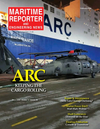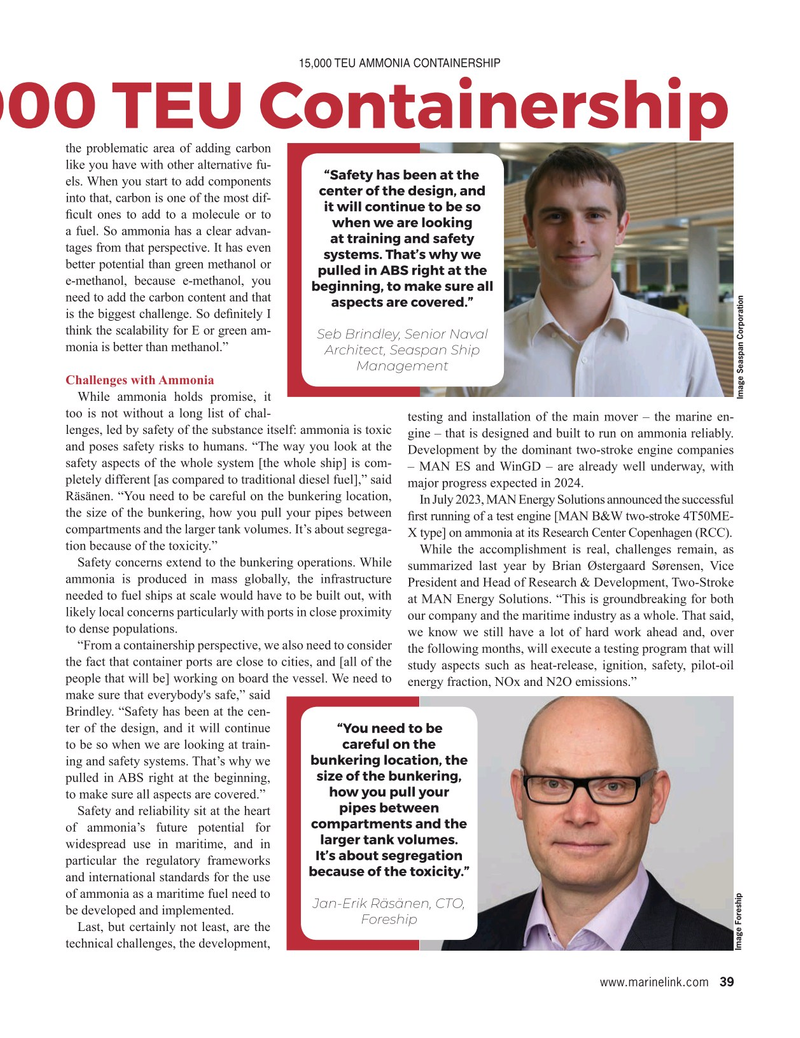
Page 39: of Maritime Reporter Magazine (February 2024)
Read this page in Pdf, Flash or Html5 edition of February 2024 Maritime Reporter Magazine
15,000 TEU AMMONIA CONTAINERSHIP 000 TEU Containership the problematic area of adding carbon like you have with other alternative fu- “Safety has been at the els. When you start to add components center of the design, and into that, carbon is one of the most dif- it will continue to be so ? cult ones to add to a molecule or to when we are looking a fuel. So ammonia has a clear advan- at training and safety tages from that perspective. It has even systems. That’s why we better potential than green methanol or pulled in ABS right at the e-methanol, because e-methanol, you beginning, to make sure all need to add the carbon content and that aspects are covered.” is the biggest challenge. So de? nitely I think the scalability for E or green am-
Seb Brindley, Senior Naval monia is better than methanol.”
Architect, Seaspan Ship
Management
Challenges with Ammonia
Image Seaspan Corporation
While ammonia holds promise, it too is not without a long list of chal- testing and installation of the main mover – the marine en- lenges, led by safety of the substance itself: ammonia is toxic gine – that is designed and built to run on ammonia reliably. and poses safety risks to humans. “The way you look at the Development by the dominant two-stroke engine companies safety aspects of the whole system [the whole ship] is com- – MAN ES and WinGD – are already well underway, with pletely different [as compared to traditional diesel fuel],” said major progress expected in 2024.
Räsänen. “You need to be careful on the bunkering location,
In July 2023, MAN Energy Solutions announced the successful the size of the bunkering, how you pull your pipes between ? rst running of a test engine [MAN B&W two-stroke 4T50ME- compartments and the larger tank volumes. It’s about segrega-
X type] on ammonia at its Research Center Copenhagen (RCC).
tion because of the toxicity.”
While the accomplishment is real, challenges remain, as
Safety concerns extend to the bunkering operations. While summarized last year by Brian Østergaard Sørensen, Vice ammonia is produced in mass globally, the infrastructure President and Head of Research & Development, Two-Stroke needed to fuel ships at scale would have to be built out, with at MAN Energy Solutions. “This is groundbreaking for both likely local concerns particularly with ports in close proximity our company and the maritime industry as a whole. That said, to dense populations.
we know we still have a lot of hard work ahead and, over “From a containership perspective, we also need to consider the following months, will execute a testing program that will the fact that container ports are close to cities, and [all of the study aspects such as heat-release, ignition, safety, pilot-oil people that will be] working on board the vessel. We need to energy fraction, NOx and N2O emissions.” make sure that everybody's safe,” said
Brindley. “Safety has been at the cen- ter of the design, and it will continue “You need to be to be so when we are looking at train- careful on the ing and safety systems. That’s why we bunkering location, the pulled in ABS right at the beginning, size of the bunkering, how you pull your to make sure all aspects are covered.” pipes between
Safety and reliability sit at the heart compartments and the of ammonia’s future potential for larger tank volumes. widespread use in maritime, and in
It’s about segregation particular the regulatory frameworks because of the toxicity.” and international standards for the use of ammonia as a maritime fuel need to
Jan-Erik Räsänen, CTO, be developed and implemented.
Foreship
Last, but certainly not least, are the technical challenges, the development,
Image Foreship www.marinelink.com 39
MR #2 (34-44).indd 39 2/7/2024 2:34:43 PM

 38
38

 40
40
